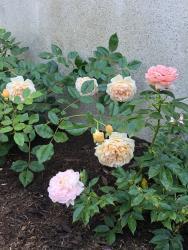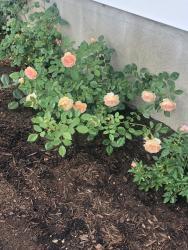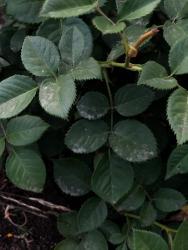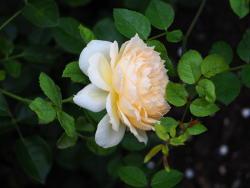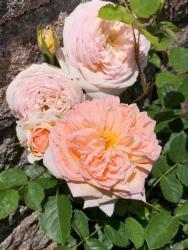We've had about 3-4 days of rain and high humidity 80-90s% day and night after a spring of little rain and a lot of hand watering in my zone 5. I've noticed that about half of the roses have developed powdery mildew and a few leaves of blackspot after all this rain and humidity and wonder if the mulch I added to the top of the soil may be impacting the plants.
Was reading up about how some mulches may lead to more fungal problems, but can't seem to find a unanimous answer. When I first planted, I covered around each bed with compost and mulch that a local landscaper friend recommended to get in bulk.
The compost is "Leaf compost, small amount of limbs and brush. Screened and windrowed for 8 months to 1.5 years. No manure."
and then an inch of mulch on top of that which I kept about 6-8 inches away from the center base of each rose:
The mulch: "100% bark, mostly hardwood, ground and broken down"
The mulch and compost layer stay pretty moist unless we have a couple of days of extreme dry heat like we did for May and the beginning of June. About a week or two ago before the rains started, I also noticed lots of little off-white mushrooms growing in the mulch.
Each plant is a bit low to the ground level of compost/mulch because I am new to this and adding the compost and mulch around them created a slight sink-hole to each after planting each so deep. The leaves yellowed at the very bottom on most of these early on but I've been doing my best to clean any fallen petals and leaves around each plant each day. Turning out to be a full time job, which I don't mind at all, I love plants. But I'm hoping I didn't mess up with the mulching or something else.
If you think it might be best, I can softly pull back the mulch I added and leave just the compost or add a better mulch. My local nursery where I got the compost and mulch sells other mulches in bags which I don't mind purchasing like these:
Coast Of Maine Dark Enriching Mulch
Coast of Maine Lobster Compost with Spaghnum Peat Moss
Coast of Maine Cow Manure Compost with Spaghnum Peat Moss
Master Nursery Bumper Crop Organic Soil Builder
and Jolly Gardener Pine Mulch
Would any of these be better to put around the roses to help fight fungal disease?
Also last question...is it normal for the stems to turn yellow/oramge right where I deadhead? I've noticed this on a few of my plants...I'll deadhead about a half an inch under the bud and a couple of days layer the small bit of stem left there before the next leaves usually yellows? In the last picture with the mildew, you can see it on the very top right.
Thanks you for any tips, hopefully they'll spring back with their green leaves and healthy growth.
